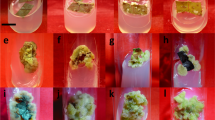Abstract
A single peak (λmax 370) yellow pigment-producing mutant derived from Monascus sp. TISTR 3179 was used for the pigment production in solid rice culture. Various factors affecting yellow tones were investigated. Hom-mali rice variety was the best amongst five Thai local varieties used for fungus culture. It was also better than corn, mungbean, soybean, potato, sweet potato, or cassava tubers. The moisture content and temperature were the key environmental factors affecting the color tones of creamy, tangerine, and golden brown rice solid cultures. The golden brown rice culture gave the highest yellow pigment concentration. Under an optimum room temperature of 28–32 °C, an initial moisture content of 42 %, and 7-day-old inoculum size of 2 % (v/w) the maximum yield at 2,224.63 A370U/gdw of yellow pigment was produced. A mellow yellow powder at 550 A370U/gdw could be obtained using spray-drying techniques. The powder had a moisture content of 5.15 %, a water activity value of 0.398, a hue angle of 73.70 ° (yellowish orange), high lightness (L*) of 74.63, color saturation (C*) of 28.97, a neutral pH of 7.42, 0.12 % acidity and solubility of 0.211 g/10 ml. It was noteworthy that the Chinese fresh noodle with spray-dried yellow powder showed no discoloration during 8-day storage.



Similar content being viewed by others
References
Al-kahtani A, Hassan H (1990) Spray drying of roselle (Hibicus Sabdariffa L.) extract. J Food Sci 55(4):1073–1076
Aniya Y, Yokomakura T, Yonamine M, Nagamine T, Nakanishi H (1998) Protective effect of the mold Monascus anka against acetaminophen-induced liver toxicity in rats. Jpn J Pharmacol 78(1):79–82
Fielding BC, Holker JSE, Jone DF, Powell ADG, Richman KW, Robertson A, Whalley WB (1961) The chemistry of fungi. Part XXXIX. The structure of monascin. J Chem Soc 1961:4579–4589
Francis FJ (1998) Color analysis. In: Nielsen SS (ed) Food Analysis, 2nd edn. Aspen Publishers Inc, Maryland, USA, pp 599–612
Jirasatid S, Nopharatana M, Kitsubun P, Vichitsoonthonkul T, Tongta A (2013) Statistical optimization for monacolin K and yellow pigment production and citrinin reduction by Monascus purpureus in solid-state fermentation. J Microbiol Biotechnol 23(3):364–374
Jongrungruangchok S, Kittikoop P, Yongsmith B, Bavavoda R, Tanasupawat S, Lartpornmatulee N, Thebtaranonth Y (2004) Azaphilone pigments from a yellow mutant of the fungus Monascus kaoliang. Phytochem 65:2569–2575
Kruawan K, Kangsadalampai K, Yongsmith B, Sriyapai T (2005) Effects of Monascus colorants on the mutagenicity of nitrite treated 1-aminopyrene using Ames test. Thai J Pharmal Sci 29(1–2):29–41
Manchand PS, Whalley WB, Chen FH (1973) Isolation and structure of ankaflavin: a new pigment from Monascus anka. Phytochem 12:2531–2532
Sato K, Iwakami S, Goda Y, Okuyama E, Yoshihira K, Ichi T, Odake Y, Noguchi H, Sankawa U (1992) Novel natural colorants from Monascus anka U-1. Heterocycles 34(11):2057–2060
Sato K, Goda Y, Sakamoto SS, Shibata L, Maitami T, Yamada T (1997) Identification of major pigments containing d-amino acid units in commercial Monascus pigments. Chem Pharm Bull 45:227–229
Steinkraus KH (1995) Miscellaneous oriental fermentations, Chinese soy sauce, pastes and related fermented foods. In: Steinkraus KH (ed) Handbook of indigenous fermented foods, 2nd edn. Marcel Dekker, Inc., New York, pp 626–627
Sweeny JG, Estrada-Valdes MC, Lacobucci GA, Sato H, Sakamura S (1981) Photoprotection of the red pigments of Monascus anka in aqueous media by 1,4,6-trihydroxy naphthalene. J Agric Food Chem 29(6):1189–1193
Takayuki A, Hiroshi S (1994) Novel UV-absorbing compounds TK17-P2a, FK17-P2b1, FK17-P2b2, and FK17-P3 and manufacture of the compounds with Aspergillus sp., Patent No. JP6329576.
Van de Loo HM (1976) An improved method for the quantitative determination of hexosamines according to Elson and Morgan. Anal Biochem 76:556–560
Yang CL (2009) Fermentation conditions for partial yellow, high color value red rice. Fujian J Agric Sci 4:361–364
Yongsmith B, Tabloka W, Krairak S, Bavavoda R (1990) Cassava fermentation of yellow pigments and amylolytic enzymes by a mutant of Monascus spp. in submerged cultivation. Microb Uti Renewable Resour 7:354–363
Yongsmith B, Tabloka W, Yongmanitchai W, Bavavoda R (1993) Culture conditions for yellow pigment formation by Monascus sp. KB10 grown on cassava medium. World J Microbiol Biotechnol 9:85–90
Yongsmith B, Krairak S, Bavavoda R (1994) Production of yellow pigment in submerged culture of a mutant of Monascus sp. J Ferment Bioeng 78:223–228
Yongsmith B, Kitpreechavanich V, Chitradon L, Chaisrisook C, Budda N (2000) Color mutants of Monascus sp. KB9 and their comparative glucoamylases on rice solid cultures. J of Mol Cat B Enzym 10:263–272
Zhou B, Pu YW, Zhu MJ, Liang SZ (2008) Effect of nitrogen sources on Monascus yellow pigment production by Monascus mutant. Mod Food Sci and Technol 2:123–127
Zhou B, Wang J, Pu Y, Zhu M, Liu S, Liang S (2009) Optimization of culture medium for yellow pigments production with Monascus anka using response surface methodology. Eur Food Res Technol 228:895–901
Zöchling S, Murkovic M, Pfannhauser W (2002) Effects of industrially produced flavours with pro- and antioxidative properties on the formation of the heterocyclic amine PhIP in a model system. J Biochem Biophys Method 53:37–44
Acknowledgments
This research work was financially supported by the Kasetsart University Research and Development Institute and the Center for Advanced Studies in Tropical Natural Resources, National Research Universities.
Author information
Authors and Affiliations
Corresponding author
Rights and permissions
About this article
Cite this article
Yongsmith, B., Thongpradis, P., Klinsupa, W. et al. Fermentation and quality of yellow pigments from golden brown rice solid culture by a selected Monascus mutant. Appl Microbiol Biotechnol 97, 8895–8902 (2013). https://doi.org/10.1007/s00253-013-5106-4
Received:
Revised:
Accepted:
Published:
Issue Date:
DOI: https://doi.org/10.1007/s00253-013-5106-4




